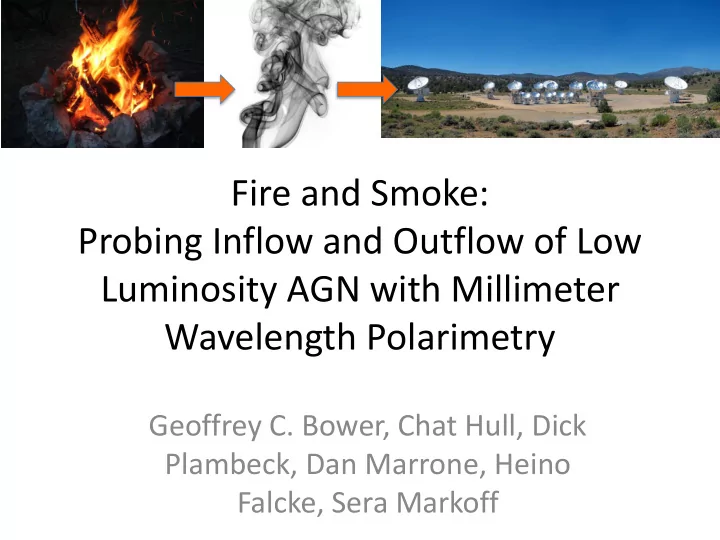

Fire and Smoke: Probing Inflow and Outflow of Low Luminosity AGN with Millimeter Wavelength Polarimetry Geoffrey C. Bower, Chat Hull, Dick Plambeck, Dan Marrone, Heino Falcke, Sera Markoff
² Sagittarius A* Event Horizon Observed Size of SgrA* ‘ ’ n’ ‘ ’
What We Don ’ t Know Yet • Why is Sgr A* so underluminous? – L ~ 10 -10 L Edd • Models degenerate – Inflow, outflow, jets, nonthermal emission • How does Sgr A* relate to other AGN? • Fundamental gravity Narayan & Quataert 2005
Sagittarius A* Polarimetry • Transition in LP fraction @~100 GHz • RM = -5 x 10 5 rad m -2 • RM stable t>10 years • Variation of intrinsic LP angle on short timescales • CP from 1.4 to 345 GHz • CP stable t >30 years
Polarization Fraction of Sgr A* Munoz et al 2011
Bower et al 2003
Bondi Radius 10 4 Schwarzschild radii Polarized radiation propagates through dense, magnetized accretion region <10 Schwarzschild radii B N e RM =-5 x 10 5 rad m -2
Bondi Accretion Material From Ruled Out Stellar Winds Too hot Too large Too dense Bondi Radius
Advection Dominated Accretion Material From Ruled Out Stellar Winds Too large Too dense Bondi Radius
Radiatively Inefficient Accretion Material From OK Stellar Winds Bondi Radius
Jet+Radiatively Inefficient Accretion Material From OK Stellar Winds Bondi Radius
Turbulent Accretion Bondi Radius 10 4 Schwarzschild radii δ B, δ Ne Polarized radiation propagates through dense, magnetized accretion region <10 Schwarzschild radii B N e RM =-5 x 10 5 rad m -2
Turbulent Accretion • Changing density/B- field in accretion region • Radius: ≥ 10 - 1000 R g • Time: hours to years – Viscous time scale • Structure function of δ RM will provide accretion structure – CARMA, SMA, ALMA
Accretion Simulations Pang, Pen, et al 2011
Simulated RMs Sensitive to • Accretion Profile • Radius of relativistic electrons • Viewing Angle Pang, Pen, et al 2011 ~1 Year • Magnetic Field Stability
Planned Simultaneous SMA/CARMA Observations • What causes the stability of the RM? • How stable and on what timescale is the RM? • Are there non- l 2 effects? • Is there a relationship between LP, CP, and RM • D RM ~ 10 4 rad m -2 variability? • D PA ~ 1 deg
CARMA Time Resolved Polarimetry of Sgr A* • 1.3 mm • October 2011 • Preliminary!
The Wildcard Event Gillessen et al 2011
LLAGN • Share many properties with Sgr A* M81 – L ~ 10 -5 L Edd • Nearby LLAGN show no or weak LP at cm wavelengths M87 8.4 GHz
M81* CARMA Upper Limits at 230 GHz LP < 1.3%
RM Limits for LLAGN • High Frequency VLA Survey Finds no LP from LLAGN up to 43 GHz • Clearly distinct from other AGN population • Assuming bandwidth depolarization, allows us to set lower limits on RM
ALMA Polarimetry of Sgr A*/LLAGN • High sensitivity to short timescale variations over wide frequency range • Sensitivity to RMs >10 12 rad m -2 • Large sample of nearby LLAGN to explore statistical properties
Summary • Polarimetry probes the turbulent accretion structures of LLAGN • EVLA/CARMA/SMA observations can provide significant improvements over the current capabilities • We need ALMA polarimetric capabilities!
Recommend
More recommend